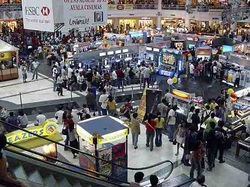 Maximizing the wall and ceiling speakers of different establishments is captive market...
Captive Market Behavior Ø Unheard – This is the lowest level of “PUBLIC CAPTIVE MARKET APPROACH.” Why still a captive market? Because the commercial is being played but can’t be heard by people due to a low sound volume level (no standard volume & equalization), high echo, high sound effects & background music volume, high ceiling speakers, fast pace announcement, & high noise pollution. When heard in a mall with a standard sound volume & later people inside increase; the sound of it decreases because of its noise pollution which loses its message clarity. People talk while shopping around when they are with friends, relatives, family, etc. These small talks produce sound that covers the volume of the ceiling or wall speakers. This lessens the value of its audio commercial which purpose is to disseminate messages. Even if we disseminate the message but it can’t be understood; still, it’s useless to narrowcast & advertise. Another problem is the echo, making the sound quality, poor. Ø Heard – This is in the mid level of “PUBLIC CAPTIVE MARKET APPROACH.” Audience are not paying attention on the commercial that is being played but unconsciously (unconsciousness as a personal habit; being unaware and intuition) or semi-consciously (semi-consciousness - awakening, implicit memory, subliminal messages, trances, hypnagogia, & hypnosis.) it gets into their mind & later remembers it because of its standard 4-time repetition of a 30-second commercial within the AST (Average Staying Time). Ø Listened - This is the highest level of “PUBLIC CAPTIVE MARKET APPROACH.” People are listening attentively and actively. Sometimes they fall asleep if it’s too long. For us, 5 minutes to 15 minutes is the best duration of having a long commercial or presentation called cadiomercial. How long is the attention span of young ages? Toddlers up to 30 minutes they get bored easily: age1-4. Children about an hour need a break: age5-11. Preteens and teenagers, two or more hour but have to be interested in what they are doing. Reference: http://answers.yahoo.com/question/index?qid=20080621025126AAsqH79. Not to mention the details of our 30 exciting contests which is our highest “attention getter.” Note: If you’re an advertiser and want to see your market hearing your commercials; all you have to do is go to that narrowcast coverage and see all your market. If you can hear your commercial; then the market that you are witnessing can also hear your commercial. Three Kinds of Captive Market Ø PRIVATE CAPTIVE MARKET - the advertiser can't witness their market; they don’t know if their target market is listening, watching or hearing their commercials because the source is in a broadcasting way of disseminating messages. These are homes, offices, private vehicles, & other private places. How can an advertiser witness its market? But still, it’s a “Captive Market” when an audience sees and hears the commercial privately on TV. Ø LIMITED PUBLIC CAPTIVE MARKET – the advertiser can witness their market but there is always a limit. It’s fine even if it is a “limited public market” as long as it has a big area. The best example here is a passenger ship/boat and commercial airplane. They have big areas but limited number of passengers. Cabvision is also an example of a limited public market. First it has a small space and area. If there is already a passenger; you can’t ask for its service anymore. If there is a TV inside the taxi; how can the advertiser witness the market? The same thing with buses. If it’s already full, you can’t get inside anymore. There’s always a limit. Ø UNLIMITED PUBLIC CAPTIVE MARKET - the advertiser can witness their market; listening, watching or hearing their commercials because of a strategic way of disseminating messages. e.g. When advertisers buy spots in a medium like POP (Point of Purchase) using the audio system of supermarkets or public places by maximizing their speakers; advertisers get more value on their commercials because they can see their target market hearing their commercials. Anyone can enter the said public place; this is why it’s called “unlimited public captive market.” Here are some examples of unlimited public captive market; amusement parks, banks, boutiques, business centers, clinics, couriers, department stores, gas stations, government places, hardware stores, hospitals, hotels, hypermarkets, malls, restaurants, salons, shops, show rooms, sports & gyms, stores, supermarkets, warehouse clubs, etc.
0 Comments
Leave a Reply. |
|
|
 RSS Feed
RSS Feed
